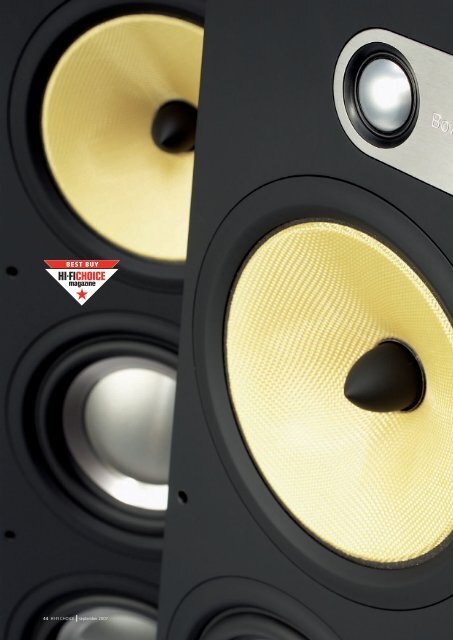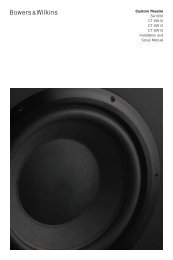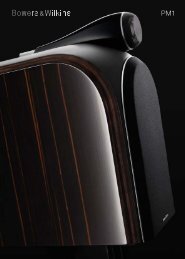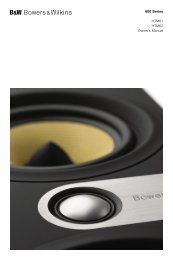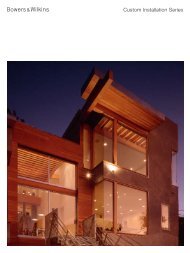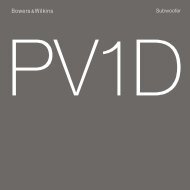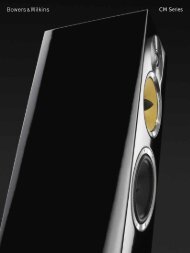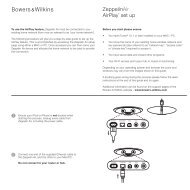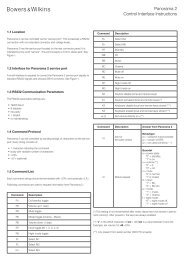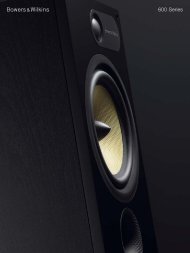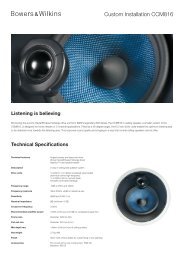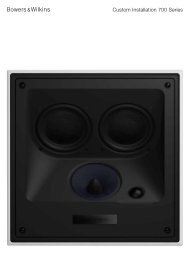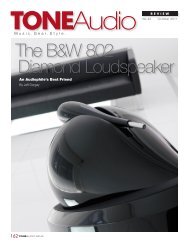Read the full review - Bowers & Wilkins
Read the full review - Bowers & Wilkins
Read the full review - Bowers & Wilkins
Create successful ePaper yourself
Turn your PDF publications into a flip-book with our unique Google optimized e-Paper software.
44 HI-FI CHOICE september 2007
B&W 683 loudspeaker [ Review ]<br />
Eight and six<br />
B&W’s astonishing new 600 Series is finally here, and <strong>the</strong> 683 has been worth <strong>the</strong> wait<br />
PRODUCT B&W 683<br />
TYPE Floorstanding loudspeaker<br />
PRICE £899<br />
KEY FEATURES Size (WxHxD):19.8x98.5x34cm<br />
P Weight: 26kg P Sensitivity: 90dB/w at 8ohms<br />
P Impedance: 8 ohms (nom) P 150mm FST midrange<br />
driver P 2x165mm aluminium/kevlar bass drivers<br />
CONTACT 01903 221500 q www.bowers-wilkins.com<br />
The 683 is <strong>the</strong> top model in B&W’s most<br />
recent incarnation of <strong>the</strong> entry-level 600<br />
Series. It’s not a speaker range to be taken<br />
lightly, especially given that B&W is one of <strong>the</strong><br />
largest dedicated loudspeaker makers in <strong>the</strong><br />
world and thus one of <strong>the</strong> biggest players in<br />
<strong>the</strong> audiophile market.<br />
The new 600 Series is smaller than previously,<br />
and <strong>the</strong>re are just two standmounts, <strong>the</strong> 686<br />
and 685, and two floorstanding stereo models,<br />
<strong>the</strong> 684 and 683. There are also three<br />
subwoofers: ASW 608, 610 and 610XP (<strong>the</strong><br />
‘8’ and ‘10’ refer to <strong>the</strong> driver size in inches,<br />
and XP essentially just means bigger and<br />
better). There are also two centre speakers and<br />
a surround speaker (detailed in <strong>the</strong> box-out).<br />
While <strong>the</strong> standmounts are very similar, except<br />
for <strong>the</strong> size of main driver and box, <strong>the</strong> two<br />
floorstanders are distinctly different. The 684<br />
(£699) is a two-and-a-half-way with two<br />
matching Kevlar cones (one dedicated to bass,<br />
<strong>the</strong> o<strong>the</strong>r to bass and mid), while <strong>the</strong> more<br />
expensive and taller 683 takes an FST<br />
midrange unit from <strong>the</strong> 800 series and<br />
augments it with two new bass drivers. All<br />
<strong>the</strong> 600 series models have <strong>the</strong> same<br />
aluminium tweeter set in its distinctively<br />
offset face plate.<br />
The FST midrange driver makes <strong>the</strong> 683<br />
<strong>the</strong> most interesting speaker in <strong>the</strong> new<br />
range. This is <strong>the</strong> same midrange<br />
technology that you will see on all of <strong>the</strong><br />
three-way 800 Series models, including <strong>the</strong><br />
mighty 800D. And given that <strong>the</strong> least<br />
expensive of those – <strong>the</strong> 804S – costs<br />
£2,700 and yet has a similar driver array,<br />
this newcomer would seem to be a bargain.<br />
Okay, it doesn’t have <strong>the</strong> fancy 800 Series<br />
cabinet work, nor <strong>the</strong> Matrix internal<br />
bracing, and its tweeter is not on top in a<br />
separate enclosure. However, <strong>the</strong>re is a<br />
Nautilus tube behind <strong>the</strong> 683’s tweeter<br />
and <strong>the</strong> bass drivers look even more ‘bling’<br />
thanks to <strong>the</strong>ir metal cones.<br />
The aluminium dome tweeter has been<br />
heavily revised for this series, its<br />
neodymium magnet giving it increased<br />
sensitivity while copper plating of <strong>the</strong> polepiece<br />
extends <strong>the</strong> frequency response.<br />
Meanwhile, mass has been lowered thanks to<br />
an edge-wound voice coil, and <strong>the</strong> resonant<br />
frequency of <strong>the</strong> system has been reduced with<br />
a new surround material.<br />
The FST midrange is distinguished by its very<br />
thin foam surround, which is a termination<br />
ra<strong>the</strong>r than a suspension as such (FST stands for<br />
Fixed Suspension Transducer). The driver can<br />
work this way because it is limited to <strong>the</strong><br />
midband and does not have a great deal of<br />
travel. B&W says that to bring <strong>the</strong> price of this<br />
drive unit down to <strong>the</strong> point where it<br />
could be used in <strong>the</strong> 600 it just simplifed <strong>the</strong><br />
mounting method to a conventional bolt-on<br />
approach, ra<strong>the</strong>r than <strong>the</strong> suspended, single<br />
point fixing used in <strong>the</strong> 800 Series. There is<br />
“The 683 is a remarkably revealing speaker<br />
for its price. You can clearly hear into <strong>the</strong><br />
mix, with fine details easily picked out.”<br />
also ano<strong>the</strong>r major factor that we will return to.<br />
The bass drivers here are aluminium cones<br />
with a paper/Kevlar skin on <strong>the</strong> back – <strong>the</strong><br />
combination giving stiffness and damping and<br />
ending up with <strong>the</strong> same mass as <strong>the</strong> carbon<br />
fibre/Rohacell-sandwich cones on <strong>the</strong> 804S.<br />
The 683 is a lot of loudspeaker for <strong>the</strong> money,<br />
its weighs in at 28kg and looks great in its<br />
Wengé vinyl skin, rubberised front panel and<br />
high quality bi-wire terminals. You may even<br />
wonder how it can be produced for <strong>the</strong> price?<br />
The answer is that B&W set up its own facility in<br />
China, moving <strong>the</strong> old 600 production line from<br />
its Worthing factory. This is <strong>the</strong> first range that<br />
<strong>the</strong> company has built overseas in its own<br />
facility and helps to explain how it can offer so<br />
much value for money. But as we know, <strong>the</strong>re’s<br />
more to <strong>the</strong> dark art of speaker building.<br />
PEFORMANCE<br />
The results are pretty damn impressive, if<br />
perhaps a little darker or more subdued than<br />
one might expect of a 600 Series speaker.<br />
Having run <strong>the</strong>m in for 24 hours things did<br />
change – <strong>the</strong> balance becoming more lively<br />
and up-front. They did this to <strong>the</strong> extent that<br />
we went from an on-axis set-up with <strong>the</strong><br />
speakers pointed at <strong>the</strong> listening chair to a<br />
straight down <strong>the</strong> room, parallel axis<br />
arrangement. Something to bear in mind<br />
should you be auditioning a brand new pair.<br />
We would be very impressed if any o<strong>the</strong>r<br />
companies could compete with <strong>the</strong><br />
bandwidth and resolution on offer from <strong>the</strong><br />
683, which is a remarkably revealing<br />
speaker for its price. You can clearly hear<br />
right into <strong>the</strong> mix, <strong>the</strong> fine details that are<br />
often masked being easily picked out. This<br />
applied equally to differences between<br />
voices in a choir and to <strong>the</strong> little extras that<br />
accompany <strong>the</strong> vocal in a densely mixed<br />
piece of hip-hop. This is partly because of<br />
<strong>the</strong> speaker’s wide dynamic range, P<br />
september 2007 HI-FI CHOICE 45
[ Review ] B&W 683 loudspeaker<br />
SET-UP<br />
Detail<br />
25mm aluminium<br />
dome tweeter<br />
150mm woven<br />
Kevlar FST midrange<br />
19.8cm<br />
60cm<br />
1.<br />
60cm<br />
1m<br />
3m<br />
3m<br />
60cm<br />
1m<br />
60cm<br />
2x165mm<br />
aluminium/<br />
paper/Kevlar<br />
bass drivers<br />
98.5cm<br />
‘Flowport’<br />
reflex port<br />
Bi-wire speaker<br />
terminals<br />
POSITIONING<br />
With its impressive bass extension you might<br />
expect <strong>the</strong> 683 to need plenty of space to<br />
avoid <strong>the</strong> bass getting too strong with respect<br />
to <strong>the</strong> midband. However, thanks to <strong>the</strong> front<br />
firing port it works surprisingly well close to<br />
a rear wall; we tried a 30cm gap between <strong>the</strong><br />
rear baffle and <strong>the</strong> wall and this didn’t seem<br />
to upset its equilibrium. If you can give it 60cm,<br />
<strong>the</strong> balance is a bit more upbeat and lively,<br />
which may be more to taste. You can also<br />
tweak <strong>the</strong> balance by <strong>the</strong> amount of toe-in you<br />
apply. With <strong>the</strong> speakers firing directly at <strong>the</strong><br />
listening position you get <strong>the</strong> most mid and<br />
treble energy – too much for our tastes to be<br />
frank – but fire <strong>the</strong>m parallel to <strong>the</strong> walls and<br />
things are more relaxed. As rooms vary a lot it<br />
pays to experiment, but 60cm to rear walls, a<br />
bit more if possible to sidewalls and a flat back,<br />
non toed-in orientation is <strong>the</strong> place to start.<br />
SYSTEM MATCHING<br />
The 683 is use<strong>full</strong>y sensitive at 90db for a<br />
nominal eight ohm load so you won’t need a<br />
monster amp to get decent level, but <strong>the</strong><br />
impedance drops to three ohms for a while, so<br />
even though <strong>the</strong> spec suggests power ratings<br />
from 25 to 200 watts we’d recommend<br />
you avoid much less than 50 watts from a<br />
solid-state amp at least. This is also a pretty<br />
revealing speaker, so avoid anything<br />
aggressive or edgy unless you are<br />
into an edge-of-<strong>the</strong>-seat balance.<br />
The most economical amplifiers<br />
that will give this speaker a<br />
chance to strut its stuff would<br />
include <strong>the</strong> Cambridge Azur<br />
840A, Naim Nait 5i and Arcam<br />
DiVA A70. As far as sources go<br />
both <strong>the</strong> Naim and Cambridge<br />
amps have partners that more<br />
than make <strong>the</strong> grade, while you<br />
need to pay a little more for an<br />
Arcam FMJ CD36. Just remember<br />
that <strong>the</strong> source is still king when it<br />
comes to it.<br />
TAKING IT MULTICHANNEL<br />
If you plan to build a multichannel system around<br />
<strong>the</strong> 683, B&W encourages you to choose its 683<br />
<strong>the</strong>atre set-up. this adds <strong>the</strong> HTM61 (£399) centre<br />
speaker, DS3 (£549) surround and an ASW610XP<br />
(£699) subwoofer. The nice thing about <strong>the</strong><br />
HTM61 is that it has <strong>the</strong> same FST midrange driver<br />
as <strong>the</strong> 683, so you are assured of <strong>the</strong> same level of<br />
resolution across <strong>the</strong> critical front speakers.<br />
However, it has a Kevlar driver ra<strong>the</strong>r than metal<br />
bass driver, (albeit in <strong>the</strong> same size chassis) as <strong>the</strong><br />
bass units on <strong>the</strong> 683. This presumably, because<br />
home cinema systems hand <strong>the</strong> lowest bass duties<br />
to <strong>the</strong> subwoofer.<br />
If you are putting toge<strong>the</strong>r a multichannel system<br />
primarily for music, however, a third DS3 and no<br />
sub would, perhaps, be <strong>the</strong> best course. The DS3 is<br />
a selectable dipole or monopole surround speaker,<br />
its switchability ensuring even sound dispersion<br />
even if placement is restricted.<br />
Q its sensitivity to <strong>the</strong> smallest notes even<br />
when <strong>the</strong>re are far louder ones threatening to<br />
hide <strong>the</strong>m. It also comes down to excellent<br />
separation of instruments and voices, it’s easy<br />
to pick out <strong>the</strong> little bits because <strong>the</strong>re seems to<br />
be more space between <strong>the</strong>m and <strong>the</strong> centre of<br />
<strong>the</strong> musical action.<br />
The 683’s bass extension and power adds<br />
genuine gravitas to piano and<br />
orchestra, and for that matter <strong>the</strong><br />
less cultivated productions<br />
of Dr Dre, Tool and Mr Oizo<br />
where <strong>the</strong> floor literally starts<br />
to resonate at specific<br />
frequencies. Something that<br />
one does not really expect of<br />
speakers at this price,<br />
especially ones that also<br />
deliver tunefulness and control<br />
at low frequencies. Helge<br />
Sunde’s brass extravaganza<br />
positively bounces with zip in<br />
<strong>the</strong> B&W’s hands, with <strong>the</strong><br />
instruments taking a solid<br />
physical form in <strong>the</strong> room.<br />
We found little to criticise in<br />
this speaker given its price. It inevitably doesn’t<br />
have <strong>the</strong> slam of something like an 804S, nor<br />
does it deliver <strong>the</strong> depth of image of more<br />
expensive designs. But when it comes to sheer<br />
resolution and lack of colouration from a<br />
speaker that also does proper bass, it is in a<br />
class of its own. By getting its FST driver into a<br />
sub-£1,000 speaker B&W has without doubt<br />
raised <strong>the</strong> stakes for <strong>the</strong> market as a whole. You<br />
may be able to get real veneers on smaller<br />
speakers but you will struggle to find <strong>the</strong><br />
combination of resolution, timing and energy<br />
in this competitive sector. HFC<br />
Jason Kennedy<br />
VERDICT<br />
SOUND >> 90%<br />
EASE OF DRIVE >> 88%<br />
BUILD >> 85%<br />
VALUE >> 95%<br />
R PRO<br />
Remarkably revealing<br />
and a wide dynamic range<br />
combine with impressive bass<br />
extension and a lovely<br />
rubberised front baffle.<br />
S CON<br />
Vinyl finish won’t be<br />
to all tastes. They will also<br />
reveal any limitations in<br />
partnering ancillaries and<br />
could damage your<br />
neighbourly relations!<br />
CONCLUSION<br />
By taking <strong>the</strong> fundamentals of <strong>the</strong> 804S and putting <strong>the</strong>m in<br />
a solid box, B&W has laid down <strong>the</strong> gauntlet at this price point.<br />
We have not come across this level of transparency in a sub-<br />
£1,000 speaker before – <strong>the</strong> killer bass is <strong>the</strong> icing on <strong>the</strong> cake.<br />
OVERALL SCORE 90% >><br />
46 HI-FI CHOICE september 2007


